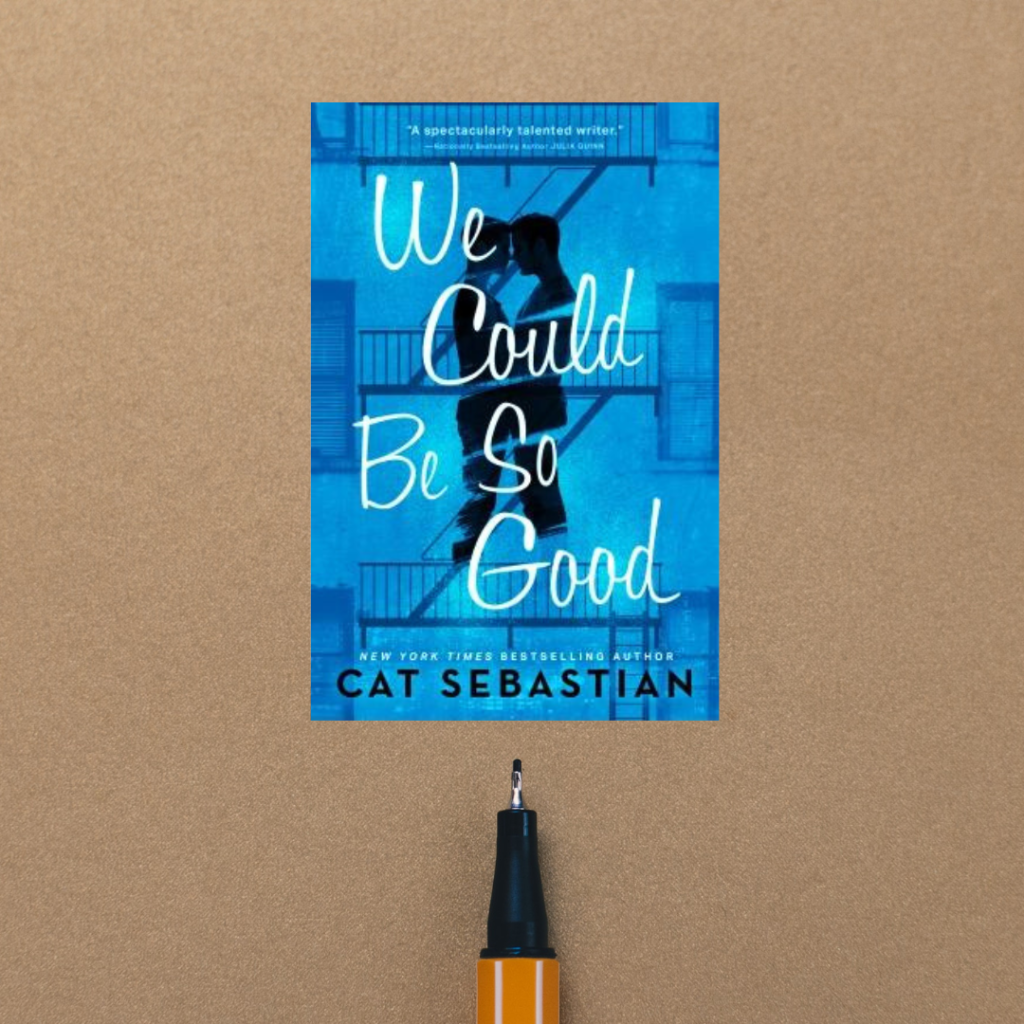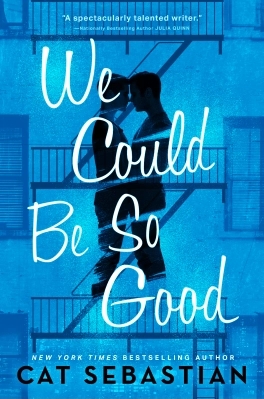
This post is Part 3 of “In Conclusion: A Four-Part Series on Epilogues and Endings in Queer Love Stories.” Before reading any of the individual close readings, I’d recommend checking out the introduction to the series here first. Part 1 discusses Something Spectacular by Alexis Hall, and Part 2 talks about Even Though I Knew The End by C. L. Polk- I’d only recommend reading those if you’ve already read the books. Enjoy!
We Could Be So Good tells the story of Nick and Andy: two men who work together at a New York City newspaper, become friends and roommates, and slowly realize that they might also be in love. In today’s post, I’ll be exploring how the epilogue negotiates the characters’ uncertainty about their own future, the genre’s reassurance of the HEA, and the readers’ knowledge of how history shaped queer people’s lives in the years following the book’s conclusion. Here’s the cover and blurb:

Nick Russo has worked his way from a rough Brooklyn neighborhood to a reporting job at one of the city’s biggest newspapers. But the late 1950s are a hostile time for gay men, and Nick knows that he can’t let anyone into his life. He just never counted on meeting someone as impossible to say no to as Andy.
Andy Fleming’s newspaper-tycoon father wants him to take over the family business. Andy, though, has no intention of running the paper. He’s barely able to run his life—he’s never paid a bill on time, routinely gets lost on the way to work, and would rather gouge out his own eyes than deal with office politics. Andy agrees to work for a year in the newsroom, knowing he’ll make an ass of himself and hate every second of it.
Except, Nick Russo keeps rescuing Andy: showing him the ropes, tracking down his keys, freeing his tie when it gets stuck in the ancient filing cabinets. Their unlikely friendship soon sharpens into feelings they can’t deny. But what feels possible in secret—this fragile, tender thing between them—seems doomed in the light of day. Now Nick and Andy have to decide if, for the first time, they’re willing to fight.
Cover image, blurb, and content notes at the author’s website.
We Could Be So Good concludes with an epilogue. As it opens, Andy is about to get promoted at the newspaper his father owns, Nick is about to take a new job elsewhere to avoid a romantic conflict of interest, and they are about to start renovations on their apartment building. They’re throwing a party, their friends all gathered to celebrate these life milestones, and the story concludes on Andy’s musings about what might come next.
It strikes him all at once – the collision of past and future he’s been experiencing over the past months. This place – this building, this apartment, their home – will be the place they lived when they were young. One day they’ll be somewhere else, and the things that are new and exciting now will be old and familiar then; they’ll learn to take for granted easy kisses and morning coffee. He can feel the wispy end of a filament that could stretch out to infinity, the end of a rope that reaches to an anchor at the bottom of the sea. For now he reaches for Nick’s hand.
While the epilogue takes place only a short time after the events of the main narrative, the final passage reassures readers about the permanence of Nick and Andy’s HEA. My favorite sentence has to be this one: “This place – this building, this apartment, their home – will be the place they lived when they were young.” The sentence starts with a progression that puts an emphasis on the present, on what is right in front of the characters, with the demonstrative pronoun “this” (this place, this building, this apartment) and then closes it with a more permanent and stable possessive “their” (their home). The second half of the sentence executes a neat temporal reversal, showing us in the span of a few sentences how the future (“will be”) becomes the past (“when they were young”). The impression on the reader is of narrative omniscience and prescience. This passage is all about the narrator telling us that everything will be ok, that Nick and Andy will look back happily on this house as part of their shared past.
In reading this passage, I thought a lot about a perennial favorite topic of debate for romance readers : whether there really is a functional difference between HEA (“happily ever after”) and HFN (“happy for now”). HFN, it is said, offers no permanent guarantees of the future. But is that really a meaningful distinction? The permanency of the future is never guaranteed, and even couples with the most solid commitment to the eternity of their love could meet an unexpected and untimely end. Of course, as romance readers, we claim the prerogative to eschew the unexpected and the untimely, and to believe that every couple we love lives out their days happy and together. On that count, too, the HEA/HFN distinction is perhaps irrelevant: as long as we’re always pretending couples stay together forever, what difference does the narrative’s chosen endpoint make?
For my part, I have always held on to the idea of an HEA/HFN distinction, one that comes down to how characters articulate the permanence of their relationship to each other and to the reader. HEAs end with the characters pledging forever, and with narrative or stylistic reassurances of what the relationship will look like in the future. HFNs end with no promises, but with reminders to readers that love, even when it might not last, has no less value for its impermanence.
What that distinction ultimately down boils to, I think, is how – and whether – the text decides to help the reader bridge the gap between where the story leaves off, and the present moment of reading. We are always projecting an imagined future into that gap, whenever we read romance. That act, however, takes on particular contours in queer historical romances like We Could Be So Good. In order to talk about that, I think it’s necessary to dig in a bit to the complicated question of how queer romance gets historicized.
While I’ve seen adjectives like “fluffy” and “escapist” applied to Andy and Nick’s story, it’s also very deeply enmeshed in the realities of its period, from the sights and sounds of New York City in 1959 to the blackmail and arrest threats Nick faces as a closeted gay man reporting on police corruption. I get the sense that there’s been a gamut of reader reactions to the choice to include the menace of period-accurate homophobia, with some readers feeling that threats of outing loom too heavy over an otherwise lighthearted book, others arguing that the sense of threat is not prevalent enough to be “historically accurate,” and still others finding that the way the threat is posed but repeatedly thwarted in favor of plot-de-escalation feels like an appropriate balance, a protection of the characters.
While all three of these individual reader responses are valid, from an analytical standpoint I’m more interested in how “period accuracy” within the text prompts the reader to think about its ending. The presence of historical realities in the text cannot help but raise, I think, the specter of future historical events that will shape Nick and Andy’s lives. The homophobia they face will not disappear after the last page of the narrative. Readers also know that, as New York City residents, the two men will bear witness to Stonewall, to the sea changes it brings, and to the AIDS epidemic. The idea that historical romance protagonists will face global upheavals that they cannot forsee, even though readers can, is not at all unique to queer romance. But I do sometimes suspect that queer HEAs are more heavily scrutinized by readers for historicity – more often read for signs of suffering and survival to come. Which, in turn, makes me wonder what strategies romance writers have found to push back, to carve out a sense of the future in the face of their readers’ knowledge of the past.
A text that I found helpful as I tried to think through this question is the introduction to Jack Halberstam’s In A Queer Time And Place. Halberstam argues, essentially, that there is such a thing as “queer time.” Threats to queer people’s safety and longevity have often meant finding different ways to think about time and the future. Yet Halberstam’s argument in fact goes quite a bit further than that. In A Queer Time suggests that the way society conceives of the very nature of time is deeply enmeshed with linear progression through social conventions like marriage, procreation, rites of passage within the nuclear family, legal inheritance: all structuring principles denied to queer people in various ways through history. In response to existing outside of heteronormative time frames, queer communities have created “alternative temporalities,” different ways of thinking about the future that “lie outside of those paradigmatic markers of life experience” (2).
One of the most interesting examples of heteronormative organizations of time is what Halberstam calls “hypothetical temporality – the time of “what if”—that demands protection in the way of insurance policies, health care, and wills” (5). While literature or genre or HEAs aren’t directly under discussion here, I was struck by just how resonant this felt to me: that being denied shared access to “insurance policies, health care, and wills” as a means of securing the future means having to create new relationships to time. Halberstam’s notion of “queer time” means not just thinking about different possibilities for the future, but to think about time itself differently, and how it might be restructured against traditional hetero-temporalities.
This is where I want to bring us back to that last passage of We Could Be So Good, because I think it’s juggling three different timelines simultaneously, in a way that resonates with the idea of alternative queer temporalities. There’s Andy’s time, which cannot access the future beyond the present moment. There’s the narrator’s time, which uses a 3rd-person semi-omniscience to report that the two men will live together long enough to look back on the current moment with fondness. And there’s the reader’s time, which has to bridge together Andy’s uncertainty with the narrator’s assurance, over the chasm of historical events we already know to have passed. With that in mind, I think we can see how the three final images bring together the ambiguity of reader’s time…
He can feel the wispy end of a filament that could stretch out to infinity
… the assured clarity of narrative time ….
the end of a rope that reaches to an anchor at the bottom of the sea
… and the hopeful uncertainty of characters’ time.
For now he reaches for Nick’s hand.
That all three of these exist at once, moving beyond the dichotomous structure of HEA or HFN, speaks to what prose can do to create a sense of queer time in historical romance.